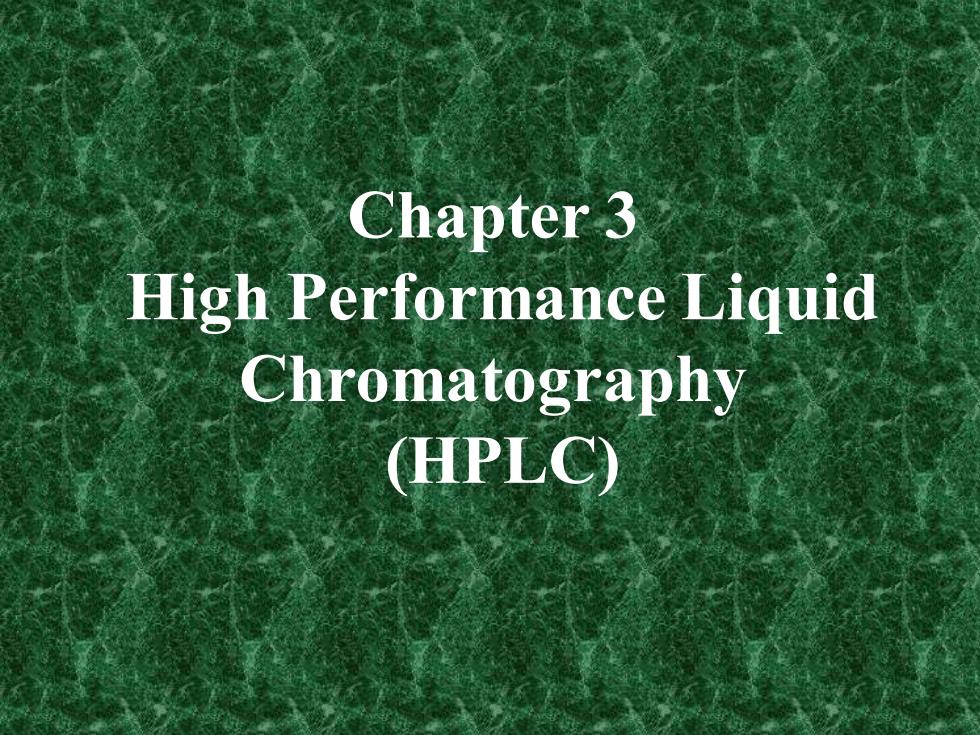
Chapter 3 High Performance Liquid Chromatography (HPLC)
Chapter 3 High Performance Liquid Chromatography (HPLC)

Outline of chapter 3 • Characteristics of HPLC(特点) • Structure of high performance liquid chromatographer (仪器构造) • Types and separation principles of HPLC methods(方法的类型及其 分离原理) • Factors influencing broadening of chromatographic peaks and separation(影响色谱峰扩展及色谱分离的因素) • Stationary phase of HPLC(液相色谱固定相) • Mobile phase of HPLC(液相色谱流动相) • Selection of chromatographic methods(色谱方法的选择) • Requirements:要求掌握HPLC法的基本原理 • Emphases: 重点学会色谱分析方法的选择
Outline of chapter 3 • Characteristics of HPLC(特点) • Structure of high performance liquid chromatographer (仪器构造) • Types and separation principles of HPLC methods(方法的类型及其 分离原理) • Factors influencing broadening of chromatographic peaks and separation(影响色谱峰扩展及色谱分离的因素) • Stationary phase of HPLC(液相色谱固定相) • Mobile phase of HPLC(液相色谱流动相) • Selection of chromatographic methods(色谱方法的选择) • Requirements:要求掌握HPLC法的基本原理 • Emphases: 重点学会色谱分析方法的选择

§3-1 Characteristics of HPLC ●High pressure Because carrier liquid moving through the column endures high resistance, high pressure must be provided Usually The pressures for supplying carrier liquid(供液压力)and for injection sample(进样压力)reach 150 ~ 350×105 Pa ●High velocity Flow rate of carrier liquid: 1 ~ 10mL.min-1 , much faster than classical liquid chromatography. Analytical velocity is much faster than classical LC. It usually takes less than 1 hour
§3-1 Characteristics of HPLC ●High pressure Because carrier liquid moving through the column endures high resistance, high pressure must be provided Usually The pressures for supplying carrier liquid(供液压力)and for injection sample(进样压力)reach 150 ~ 350×105 Pa ●High velocity Flow rate of carrier liquid: 1 ~ 10mL.min-1 , much faster than classical liquid chromatography. Analytical velocity is much faster than classical LC. It usually takes less than 1 hour
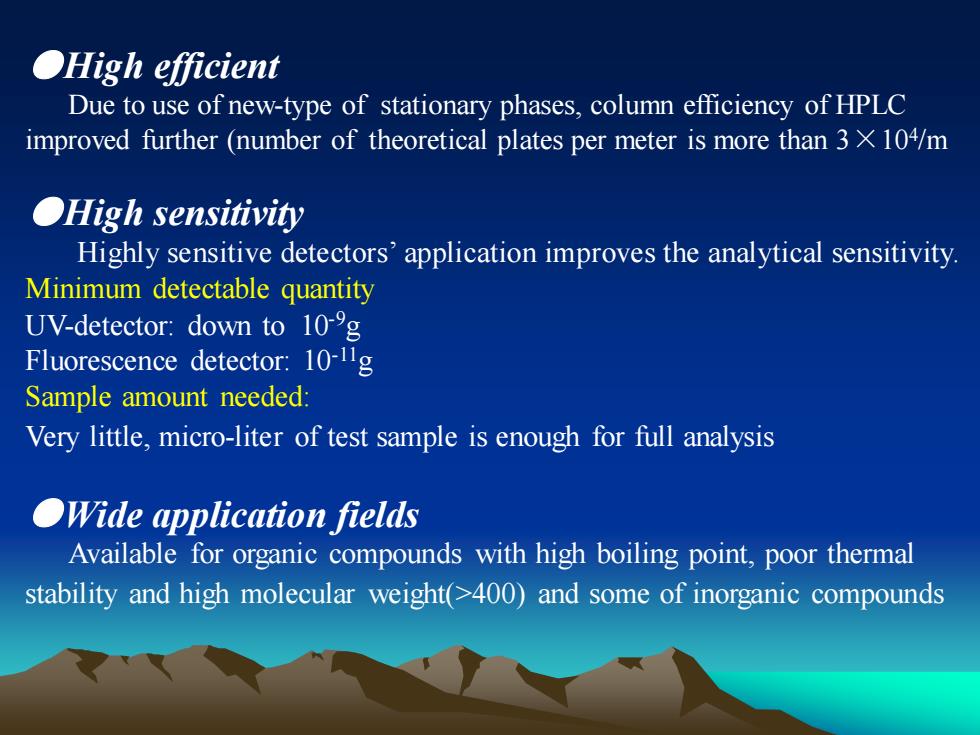
●High efficient Due to use of new-type of stationary phases, column efficiency of HPLC improved further (number of theoretical plates per meter is more than 3×104 /m ●High sensitivity Highly sensitive detectors’ application improves the analytical sensitivity. Minimum detectable quantity UV-detector: down to 10-9g Fluorescence detector: 10-11g Sample amount needed: Very little, micro-liter of test sample is enough for full analysis ●Wide application fields Available for organic compounds with high boiling point, poor thermal stability and high molecular weight(>400) and some of inorganic compounds
●High efficient Due to use of new-type of stationary phases, column efficiency of HPLC improved further (number of theoretical plates per meter is more than 3×104 /m ●High sensitivity Highly sensitive detectors’ application improves the analytical sensitivity. Minimum detectable quantity UV-detector: down to 10-9g Fluorescence detector: 10-11g Sample amount needed: Very little, micro-liter of test sample is enough for full analysis ●Wide application fields Available for organic compounds with high boiling point, poor thermal stability and high molecular weight(>400) and some of inorganic compounds
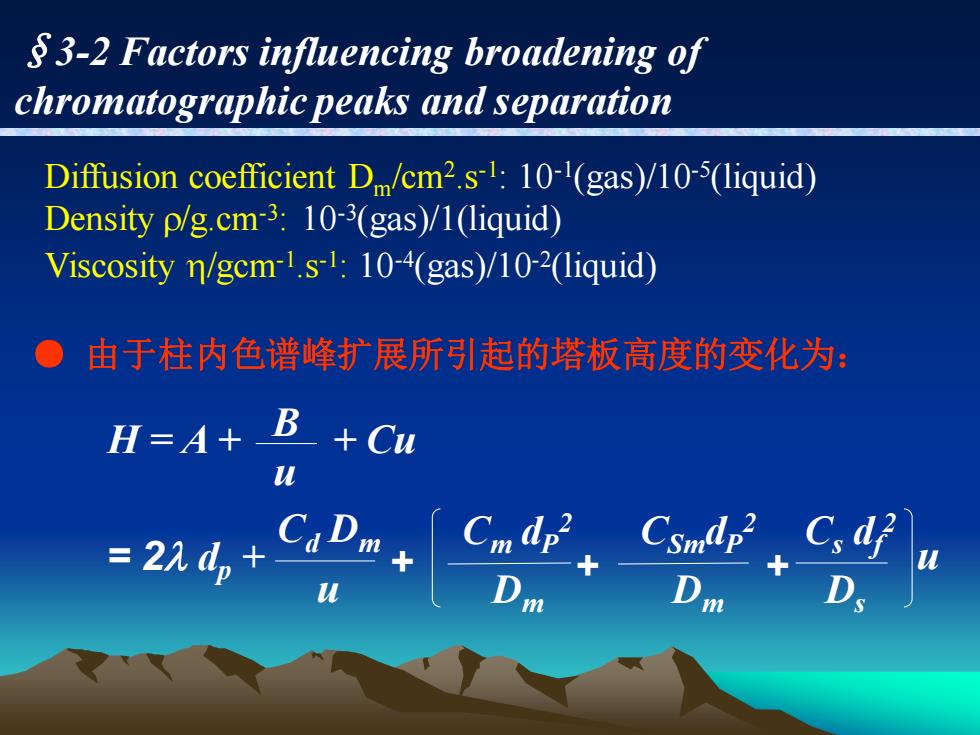
§3-2 Factors influencing broadening of chromatographic peaks and separation Diffusion coefficient Dm/cm2 .s-1 : 10-1 (gas)/10-5 (liquid) Density /g.cm-3 : 10-3 (gas)/1(liquid) Viscosity /gcm-1 .s-1 : 10-4 (gas)/10-2 (liquid) = 2l dp + Cd Dm u + Cm dP 2 CSmdP 2 Cs df 2 Dm Dm Ds + + u H = A + + Cu B u ● 由于柱内色谱峰扩展所引起的塔板高度的变化为:
§3-2 Factors influencing broadening of chromatographic peaks and separation Diffusion coefficient Dm/cm2 .s-1 : 10-1 (gas)/10-5 (liquid) Density /g.cm-3 : 10-3 (gas)/1(liquid) Viscosity /gcm-1 .s-1 : 10-4 (gas)/10-2 (liquid) = 2l dp + Cd Dm u + Cm dP 2 CSmdP 2 Cs df 2 Dm Dm Ds + + u H = A + + Cu B u ● 由于柱内色谱峰扩展所引起的塔板高度的变化为:
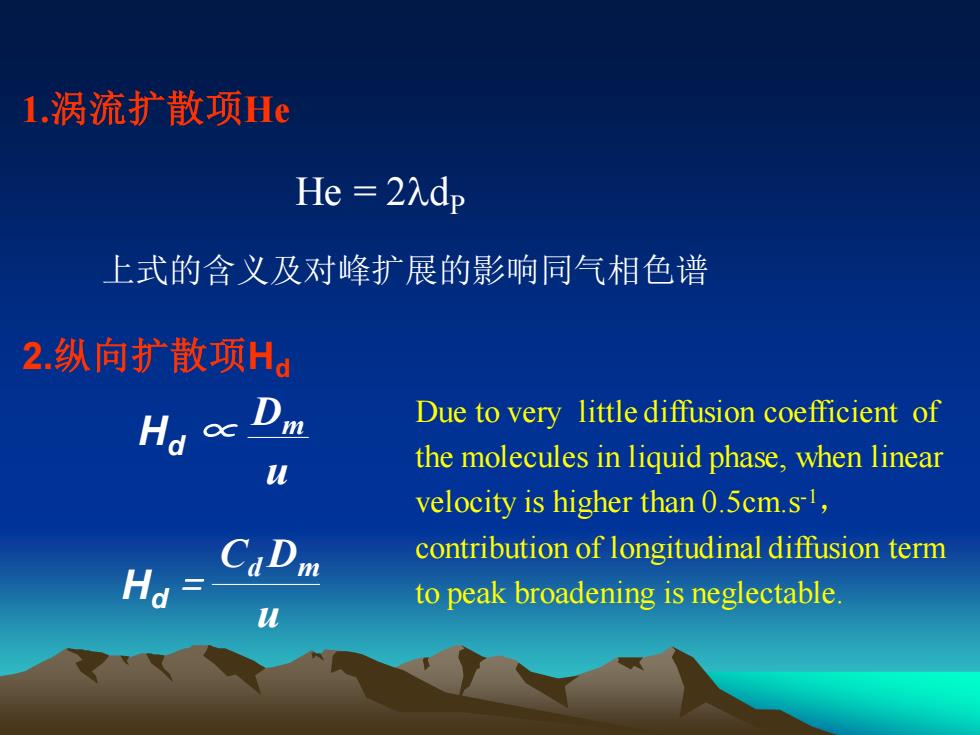
1.涡流扩散项He He = 2ldP 上式的含义及对峰扩展的影响同气相色谱 2.纵向扩散项Hd Hd ∝ Dm u Hd = Cd Dm u Due to very little diffusion coefficient of the molecules in liquid phase, when linear velocity is higher than 0.5cm.s-1 , contribution of longitudinal diffusion term to peak broadening is neglectable
1.涡流扩散项He He = 2ldP 上式的含义及对峰扩展的影响同气相色谱 2.纵向扩散项Hd Hd ∝ Dm u Hd = Cd Dm u Due to very little diffusion coefficient of the molecules in liquid phase, when linear velocity is higher than 0.5cm.s-1 , contribution of longitudinal diffusion term to peak broadening is neglectable
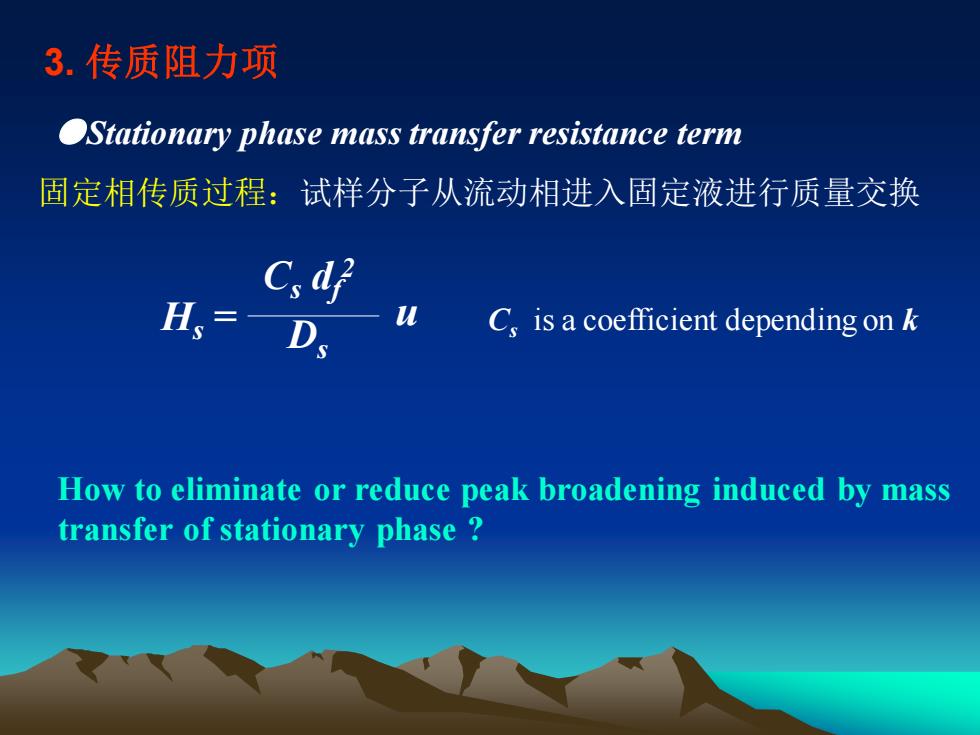
3. 传质阻力项 ●Stationary phase mass transfer resistance term 固定相传质过程:试样分子从流动相进入固定液进行质量交换 Hs = Cs df 2 Ds u Cs is a coefficient depending on k How to eliminate or reduce peak broadening induced by mass transfer of stationary phase ?
3. 传质阻力项 ●Stationary phase mass transfer resistance term 固定相传质过程:试样分子从流动相进入固定液进行质量交换 Hs = Cs df 2 Ds u Cs is a coefficient depending on k How to eliminate or reduce peak broadening induced by mass transfer of stationary phase ?
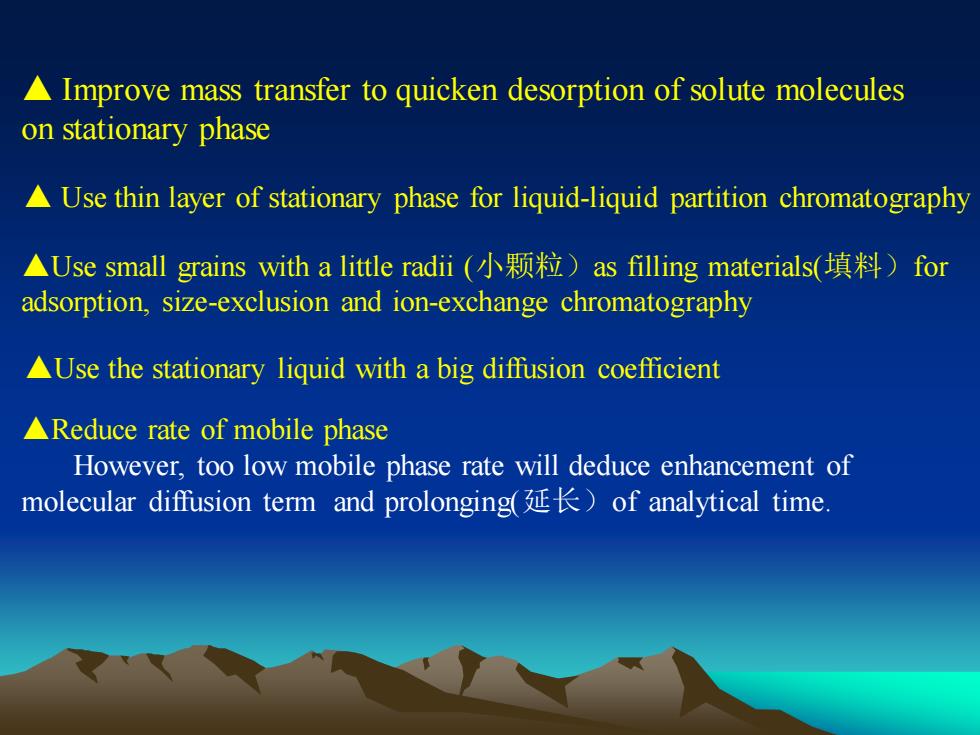
▲ Use thin layer of stationary phase for liquid-liquid partition chromatography ▲Use small grains with a little radii (小颗粒)as filling materials(填料)for adsorption, size-exclusion and ion-exchange chromatography ▲Use the stationary liquid with a big diffusion coefficient ▲Reduce rate of mobile phase However, too low mobile phase rate will deduce enhancement of molecular diffusion term and prolonging(延长)of analytical time. ▲ Improve mass transfer to quicken desorption of solute molecules on stationary phase
▲ Use thin layer of stationary phase for liquid-liquid partition chromatography ▲Use small grains with a little radii (小颗粒)as filling materials(填料)for adsorption, size-exclusion and ion-exchange chromatography ▲Use the stationary liquid with a big diffusion coefficient ▲Reduce rate of mobile phase However, too low mobile phase rate will deduce enhancement of molecular diffusion term and prolonging(延长)of analytical time. ▲ Improve mass transfer to quicken desorption of solute molecules on stationary phase
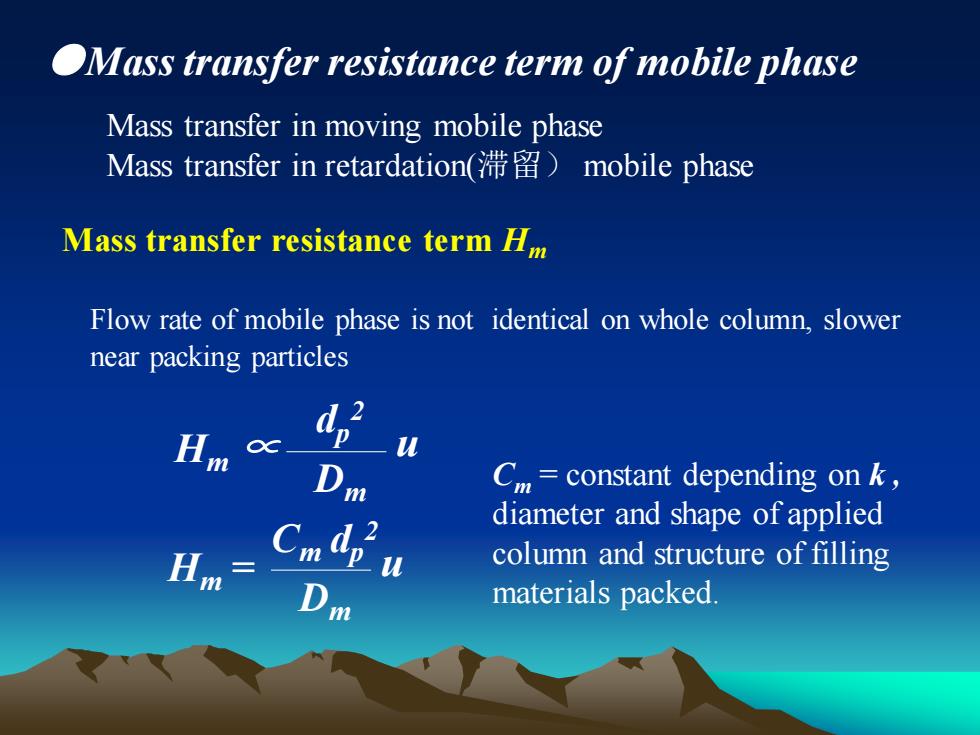
●Mass transfer resistance term of mobile phase Mass transfer in moving mobile phase Mass transfer in retardation(滞留) mobile phase Hm = Cm dp 2 Dm u Cm = constant depending on k , diameter and shape of applied column and structure of filling materials packed. Hm ∝ dp 2 Dm u Mass transfer resistance term Hm Flow rate of mobile phase is not identical on whole column, slower near packing particles
●Mass transfer resistance term of mobile phase Mass transfer in moving mobile phase Mass transfer in retardation(滞留) mobile phase Hm = Cm dp 2 Dm u Cm = constant depending on k , diameter and shape of applied column and structure of filling materials packed. Hm ∝ dp 2 Dm u Mass transfer resistance term Hm Flow rate of mobile phase is not identical on whole column, slower near packing particles
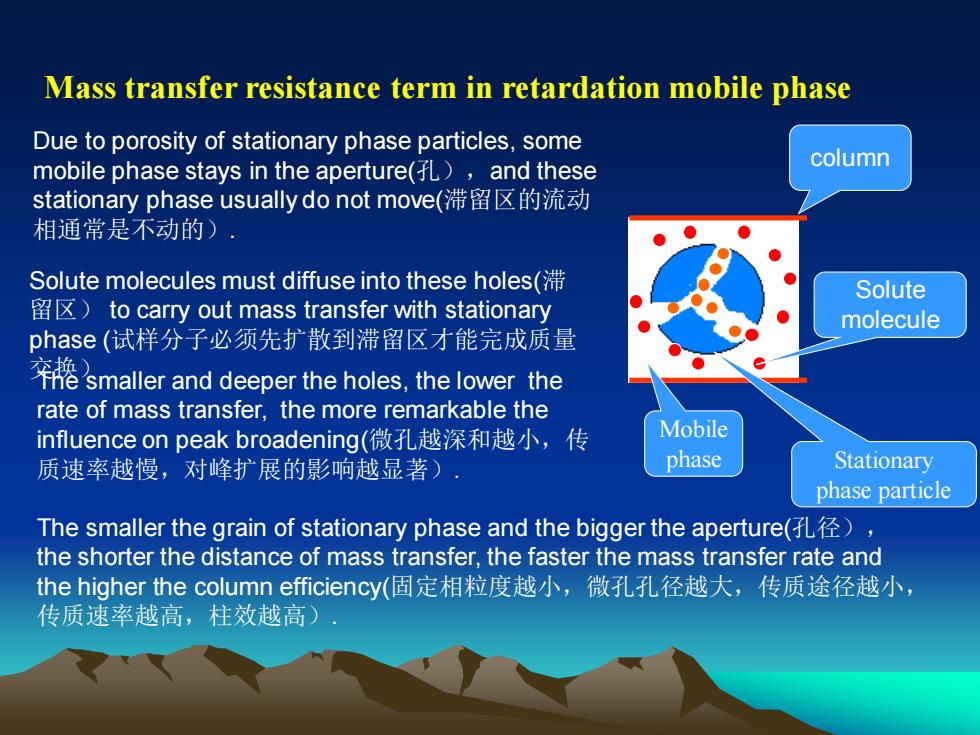
Mass transfer resistance term in retardation mobile phase column Solute molecule Stationary phase particle Mobile phase Due to porosity of stationary phase particles, some mobile phase stays in the aperture(孔),and these stationary phase usually do not move(滞留区的流动 相通常是不动的). Solute molecules must diffuse into these holes(滞 留区) to carry out mass transfer with stationary phase (试样分子必须先扩散到滞留区才能完成质量 交换) The smaller and deeper the holes, the lower the rate of mass transfer, the more remarkable the influence on peak broadening(微孔越深和越小,传 质速率越慢,对峰扩展的影响越显著). The smaller the grain of stationary phase and the bigger the aperture(孔径), the shorter the distance of mass transfer, the faster the mass transfer rate and the higher the column efficiency(固定相粒度越小,微孔孔径越大,传质途径越小, 传质速率越高,柱效越高)
Mass transfer resistance term in retardation mobile phase column Solute molecule Stationary phase particle Mobile phase Due to porosity of stationary phase particles, some mobile phase stays in the aperture(孔),and these stationary phase usually do not move(滞留区的流动 相通常是不动的). Solute molecules must diffuse into these holes(滞 留区) to carry out mass transfer with stationary phase (试样分子必须先扩散到滞留区才能完成质量 交换) The smaller and deeper the holes, the lower the rate of mass transfer, the more remarkable the influence on peak broadening(微孔越深和越小,传 质速率越慢,对峰扩展的影响越显著). The smaller the grain of stationary phase and the bigger the aperture(孔径), the shorter the distance of mass transfer, the faster the mass transfer rate and the higher the column efficiency(固定相粒度越小,微孔孔径越大,传质途径越小, 传质速率越高,柱效越高)